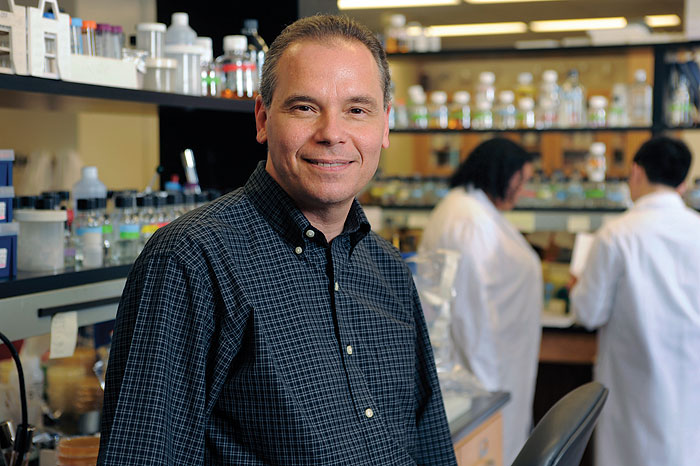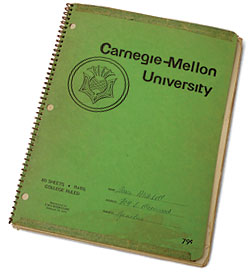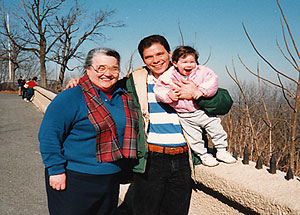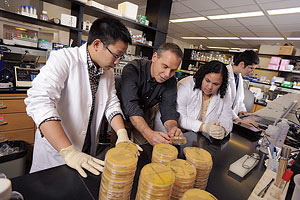
Biological Sciences Professor Comes Home
by Jennifer Bails

For Aaron Mitchell, Carnegie Mellon is a family affair.
It is here as an undergraduate that he met his wife of 31 years, Barbara Beizer Mitchell. Both earned their degrees from the Mellon College of Science in 1977. Their son Max is now a senior mathematical sciences major at the university. And two years ago, Mitchell decided to return to Carnegie Mellon as a professor in the Department of Biological Sciences after 21 years on the faculty at Columbia University Medical Center.
"I have always felt a very close connection to this institution," he says. "I can trace my success in life back to a few key relationships and a few key courses, all of which happened here."

Mitchell’s notebook from his, and the university’s, first genetics class taught by Beth Jones.
Raised in New York City as the son of two Columbia music professors, Mitchell chose Carnegie Mellon sight unseen with the intention of studying math. Then on a whim he took the school's first-ever genetics class taught by internationally renowned geneticist Elizabeth Jones in the spring of 1975. "Beth got me totally addicted," he recalls. Mitchell went on to work in Jones's lab, where he developed a fascination with yeast genetics. He stayed in close touch with his influential mentor and friend after earning his doctorate at MIT in 1984. A phone call from her helped him land a postdoctoral fellowship at the University of California, San Francisco, and throughout his tenure at Columbia, Jones tried to woo her protégé back to Carnegie Mellon.
"When my son was admitted here as a freshman, Beth called up and said, ‘Now you are going to move here,' and I finally said, ‘OK,' " says Mitchell, laughing.

Aaron Mitchell with Beth Jones and his daughter Hannah in 1988.
Jones passed away in 2008, shortly before Mitchell's return. Now he is carrying on her legacy, both as an accomplished researcher and dedicated educator, while blazing important new trails in the laboratory and classroom.
Mitchell spent years doing basic genetics research in the yeast model. After an inspiring sabbatical at Merck in 1995, he sought to tie his work more closely to human health. Today his lab takes an applied approach to the study of Candida albicans, a commensal type of yeast naturally found in the gastrointestinal and genitourinary tracts. These yeast often grow as biofilms-aggregates of microorganisms in which cells adhere to a surface and to each other.
But when Candida cells break off from these biofilms and multiply in the bloodstream, they can cause life-threatening disseminated infection. Millions of people with implanted medical devices such as pacemakers or artificial joints (surfaces where biofilms can form) and those who take broad-spectrum antibiotics are at especially high risk. Mitchell is studying the genes that regulate Candida biofilm formation and growth, in hopes of discovering targets for small molecules that could disrupt this process and prevent deadly infection. Two promising candidates are the proteins Als3 and Hwp1.
"I'm really oriented toward therapeutic applications," Mitchell says. "I really want to get there, and I think it should be feasible."

Aaron Mitchell in his lab with undergraduates David Huang, Katie Griswold and Mike Kahn.
Outside the lab, Mitchell serves as the program director of the Howard Hughes Medical Institute (HHMI) programs at Carnegie Mellon, which helps provide research experiences for undergraduates. HHMI has funded undergraduate research at Carnegie Mellon for more than 20 years, including a recent $1 million grant in May. Mitchell also has been working to update the curriculum in biological sciences, especially the mathematics component, and this is leading to broader discussions of the core curriculum shared across majors in MCS.
It's been an intense homecoming for Mitchell, but the reward comes when he sees "the light bulbs go on" on the faces of his students during a lecture. "There is an attitude of inquiry among the students here that makes this a fantastic place to work and teach," he says. "They really are curious about what's going on in the world. They want to come up with their own way of seeing things and their own solutions to problems."
These are the same qualities that Mitchell now sees in his own son-and that Jones likely saw in him several decades ago. It's also one of the factors reaffirming his choice to come back to Carnegie Mellon.
"As you get on in academics, you invest more and more time in your institution, and you want to make sure this extra effort goes to a place that you believe in," he says. "That made it a very easy decision to come here."
Photo credits, from top: Ken Andreyo; courtesy Aaron Mitchell; courtesy Aaron Mitchell; Ken Andreyo.